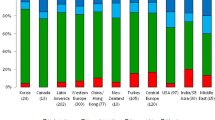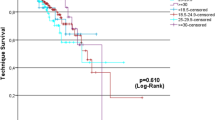Abstract
Background
The incidence of obesity is increasing both in the general population and in incident dialysis patients. While there is evidence that being overweight is associated with good outcomes in hemodialysis, the evidence in peritoneal dialysis (PD) patients is not very clear. We studied a modern cohort of PD patients to examine outcomes in large patients.
Methods
Forty-three patients who started PD, who weighed more than 90 kg at dialysis initiation, between January/2000 and June/2010 were matched with 43 control patients who weighed less than 90 kg. Detailed review of the charts was undertaken.
Results
The mean weight and body mass index of the wt < 90 kg group were 69.3 ± 11.3 kg and 25.0 ± 3.9 kg/m2. The number of peritonitis episodes per year was 0.33 ± 0.6 (wt < 90 kg) and 0.82 ± 1.7 (wt ≥ 90 kg) (p = 0.26). The median time to first peritonitis showed a trend toward earlier peritonitis in larger patients [9.5 (4.3, 27) months in wt ≥ 90 kg, 19.1(7.9, 30.8) months in wt < 90 kg] but did not reach statistical significance (p = 0.12). Surprisingly, hernias and leaks were more common in the weight <90 kg group (44 vs. 18.6 % p = 0.02). There was no difference in total number of hospitalizations or the number of days hospitalized. Kaplan–Meier analysis of survival on PD showed no differences between the two groups (logrank p = 0.99). Cox regression analysis using age, race, cause of ESRD due to diabetes and Charlson comorbidity index as the covariates did not show weight to be associated with survival on PD.
Conclusions
Large patients tend to do just as well on PD, with survival on PD being no different compared to individuals with lower weight and body mass index.

Similar content being viewed by others
References
Kramer HJ, Saranathan A, Luke A, Durazo-Arvizu RA, Guichan C, Hou S, Cooper R (2006) Increasing body mass index and obesity in the incident ESRD population. J Am Soc Nephrol 17(5):1453–1459. doi:10.1681/ASN.2005111241
Kalantar-Zadeh K, Streja E, Kovesdy CP, Oreopoulos A, Noori N, Jing J, Nissenson AR, Krishnan M, Kopple JD, Mehrotra R, Anker SD (2010) The obesity paradox and mortality associated with surrogates of body size and muscle mass in patients receiving hemodialysis. Mayo Clin Proc 85(11):991–1001. doi:10.4065/mcp.2010.0336
Kalantar-Zadeh K, Kopple JD, Kilpatrick RD, McAllister CJ, Shinaberger CS, Gjertson DW, Greenland S (2005) Association of morbid obesity and weight change over time with cardiovascular survival in hemodialysis population. Am J Kidney Dis 46(3):489–500. doi:10.1053/j.ajkd.2005.05.020
Johansen KL, Young B, Kaysen GA, Chertow GM (2004) Association of body size with outcomes among patients beginning dialysis. Am J Clin Nutr 80(2):324–332
Aslam N, Bernardini J, Fried L, Piraino B (2002) Large body mass index does not predict short-term survival in peritoneal dialysis patients. Perit Dial Int 22(2):191–196
McDonald SP, Collins JF, Johnson DW (2003) Obesity is associated with worse peritoneal dialysis outcomes in the Australia and New Zealand patient populations. J Am Soc Nephrol 14(11):2894–2901
Shih YC, Guo A, Just PM, Mujais S (2005) Impact of initial dialysis modality and modality switches on Medicare expenditures of end-stage renal disease patients. Kidney Int 68(1):319–329. doi:10.1111/j.1523-1755.2005.00413.x
Lang SM, Bergner A, Topfer M, Schiffl H (2001) Preservation of residual renal function in dialysis patients: effects of dialysis-technique-related factors. Perit Dial Int 21(1):52–57
Jansen MA, Hart AA, Korevaar JC, Dekker FW, Boeschoten EW, Krediet RT (2002) Predictors of the rate of decline of residual renal function in incident dialysis patients. Kidney Int 62(3):1046–1053. doi:10.1046/j.1523-1755.2002.00505.x
Rubin HR, Fink NE, Plantinga LC, Sadler JH, Kliger AS, Powe NR (2004) Patient ratings of dialysis care with peritoneal dialysis vs hemodialysis. JAMA 291(6):697–703. doi:10.1001/jama.291.6.697
Fong E, Bargman JM, Chan CT (2007) Cross-sectional comparison of quality of life and illness intrusiveness in patients who are treated with nocturnal home hemodialysis versus peritoneal dialysis. CJASN 2(6):1195–1200. doi:10.2215/CJN.02260507
U.S. Renal Data System, USRDS (2009) Annual Data Report: Atlas of End-Stage Renal Disease in the United States. National Institutes of Health, National Institute of Diabetes and Digestive and Kidney Diseases, Bethesda
Jain AK, Blake P, Cordy P, Garg AX (2012) Global trends in rates of peritoneal dialysis. JASN 23(3):533–544. doi:10.1681/ASN.2011060607
Khawar O, Kalantar-Zadeh K, Lo WK, Johnson D, Mehrotra R (2007) Is the declining use of long-term peritoneal dialysis justified by outcome data? CJASN 2(6):1317–1328. doi:10.2215/CJN.02550607
Johnson DW, Herzig KA, Purdie DM, Chang W, Brown AM, Rigby RJ, Campbell SB, Nicol DL, Hawley CM (2000) Is obesity a favorable prognostic factor in peritoneal dialysis patients? Perit Dial Int 20(6):715–721
Snyder JJ, Foley RN, Gilbertson DT, Vonesh EF, Collins AJ (2003) Body size and outcomes on peritoneal dialysis in the United States. Kidney Int 64(5):1838–1844. doi:10.1046/j.1523-1755.2003.00287.x
Thamer M, Hwang W, Fink NE, Sadler JH, Wills S, Levin NW, Bass EB, Levey AS, Brookmeyer R, Powe NR (2000) US nephrologists’ recommendation of dialysis modality: results of a national survey. Am J Kidney Dis 36(6):1155–1165. doi:10.1053/ajkd.2000.19829
Afthentopoulos IE, Oreopoulos DG (1997) Is CAPD an effective treatment for ESRD patients with a weight over 80 kg? Clin Nephrol 47(6):389–393
Piraino B, Bernardini J, Centa PK, Johnston JR, Sorkin MI (1991) The effect of body weight on CAPD related infections and catheter loss. Perit Dial Int 11(1):64–68
McDonald SP, Collins JF, Rumpsfeld M, Johnson DW (2004) Obesity is a risk factor for peritonitis in the Australian and New Zealand peritoneal dialysis patient populations. Perit Dial Int 24(4):340–346
Nessim SJ, Komenda P, Rigatto C, Verrelli M, Sood MM (2012) Frequency and microbiology of peritonitis and exit-site infection among obese peritoneal dialysis patients. Perit Dial Int. doi:10.3747/pdi.2011.00244
Tzamaloukas AH, Murata GH, Piraino B, Malhotra D, Bernardini J, Rao P, Oreopoulos DG (1999) The relation between body size and normalized small solute clearances in continuous ambulatory peritoneal dialysis. JASN 10(7):1575–1581
Tzamaloukas AH, Murata GH (1999) Peritoneal dialysis in patients with large body size: can it deliver adequate clearances? Perit Dial Int 19(5):409–414
Ramkumar N, Pappas LM, Beddhu S (2005) Effect of body size and body composition on survival in peritoneal dialysis patients. Perit Dial Int 25(5):461–469
Paniagua R, Amato D, Vonesh E, Correa-Rotter R, Ramos A, Moran J, Mujais S, Mexican Nephrology Collaborative Study Group (2002) Effects of increased peritoneal clearances on mortality rates in peritoneal dialysis: ADEMEX, a prospective, randomized, controlled trial. J Am Soc Nephrol 13(5):1307–1320
Wetherington GM, Leapman SB, Robison RJ, Filo RS (1985) Abdominal wall and inguinal hernias in continuous ambulatory peritoneal dialysis patients. Am J Surg 150(3):357–360
Acknowledgments
S. Ananthakrishnan was supported by Baxter Home Dialysis fellowship program; R. M. Elias was supported by Coordenação de Aperfeiçoamento de Pessoal de Nível Superior (CAPES), Brazil, Toronto Rehabilitation Institute and Toronto General Hospital.
Conflict of interest
The authors declare that they have no conflict of interest.
Author information
Authors and Affiliations
Corresponding author
Additional information
Dimitrios Oreopoulos—deceased.
Rights and permissions
About this article
Cite this article
Ananthakrishnan, S., Sekercioglu, N., Elias, R.M. et al. Peritoneal dialysis outcomes in a modern cohort of overweight patients. Int Urol Nephrol 46, 183–189 (2014). https://doi.org/10.1007/s11255-013-0472-5
Received:
Accepted:
Published:
Issue Date:
DOI: https://doi.org/10.1007/s11255-013-0472-5




